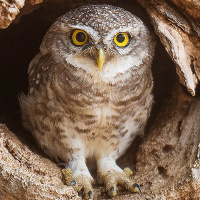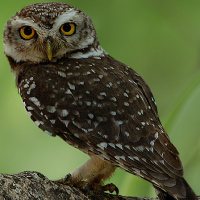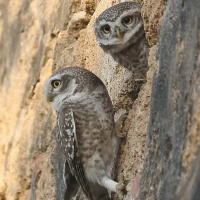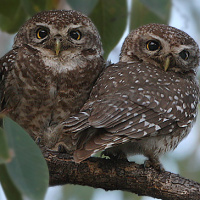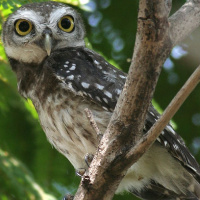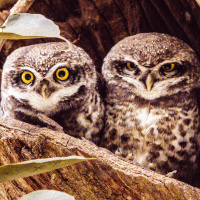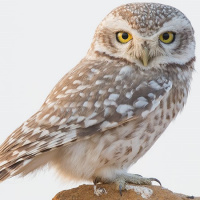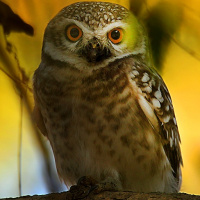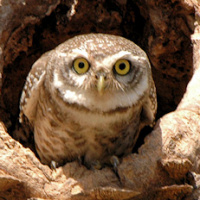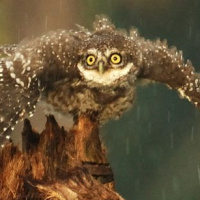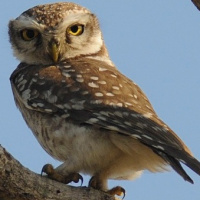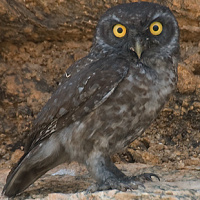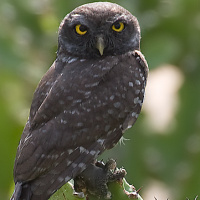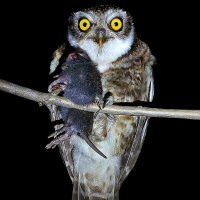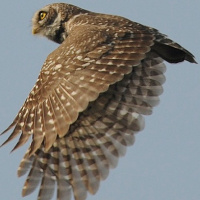Introduction
The Spotted Owlet is a small owl with a round head, yellow eyes and prominent white eyebrows. It is also known as the Spotted Little Owl.
Photo Gallery (17 pictures)
Sound Gallery
Information
Description: The facial disc is creamy-buff with brown concentric lines. The forehead and lores are white to pale buffy. Eyebrows are white
and curved. Eyes are pale to deep golden-yellow. The sides of the face are dark, contrasting with white rear edges. The cere is dusky green or greenish brown,
the bill being greenish-horn, but sometimes darker, and somtimes more yellow on the upper ridge. The crown, sides of the head, and upperparts are earth-brown
to greyish or rufescent, marked with small white spots. The nape has very large white spots, forming a collar, while the back has large white spots, and the
scapulars have broad white edges. The chin, throat, and front and sides of the neck are white, with a dark brown band below this. The remainder of the
underparts are whitish, spotted and mottled with brown, sometimes with broken bars.
The wings are spotted and banded white, and the tail has narrow white bars.
The tarsi is feathered, and the toes bristled and dirty yellowish. Claws are dark horn, and soles yellowish.
[Note: above description is for race indica, nominate race brama is generally darker and smaller]
Size: Length 19-21cm. Wing length 143-171mm. Tail length 65-93mm. Weight 110-114g. Females are usually larger than males.
Habits: Generally crepuscular and nocturnal, but sometimes seen by day. Roosts by day in tree hole or on a branch. May roost in pairs or small groups. Flight is deeply undulating, consisting of a few rapid flaps followed by a glide with wings pressed to the body.
Voice: A harsh screeching chirurrr-chirurrr-chirurrr... followed by, or alternating with cheevak, cheevak, cheevak and a variety of other screeches and chuckles.
Hunting & Food: Mainly preys upon beetles, moths and other insects. Also takes earthworms, lizards, mice and small birds. Usually hunts from a perch, pouncing on prey, but occasionally takes insects in flight. Often uses street lamps as hunting bases, hawking insects attracted to the lights.
Breeding: Northern races breed from February to April, while Southern races breed from November to March. Nests are in natural tree hollows,
or in holes and cavaties in human dwellings. May also nest in cavities in the sides of ravines and earth cliffs when suitable trees are scarce. The nest is
sometimes liked with grass and feathers.
2-3, sometimes up to 5 white, roundish oval eggs are laid (average 32.2 x 27.1mm), with incubation begining with the first egg. This causes the young to hatch
asynchronously, resulting in a considerable size difference within the brood.
Habitat: Open or semi-open country, including semi-desert. Within and on outskirts of villages and cultivation, groves with old trees, and ruins. This species avoids thick forest. Lives from sea-level to about 1400m.
Distribution: Southern Asia, from Iran to Vietnam. Present on most of the Indian subcontinent (except Sri Lanka) and Southeast Asia, except peninsular Thailand and Malaysia.

Range of the Spotted Owlet Athene brama
Status: Generally common.
Original Description: Temminck, Coenraed Jacob & Laugier de Chartrouse, (Baron) Meiffren. 1821. Nouveau recueil de planches coloriées d'oiseau pour servir de suite et de complément aux planches enluminées de Buffon, livraison 12, pl. 68.

